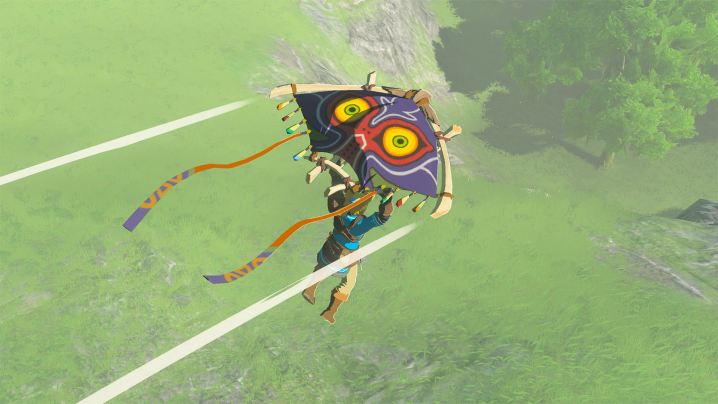
The Legend of Zelda: Tears of the Kingdom is nearly upon us, but I can’t stop thinking about Majora’s Mask.
Early Tears of the Kingdom reviews are glowing, highlighting how it deepens the way players can interact with Hyrule through features like Fuse and Ultrahand. Still, Hyrule itself looks similar to what was present in Breath of the Wild, and Tears of the Kingdom is very much a visually similar sequel that builds upon the assets and ideas established in its critically lauded predecessor. Whether that bothers you or not, no one can ignore that Tears of the Kingdom finds itself in a similar situation to Majora’s Mask.

The Nintendo 64 game, first released in 2000, had the tall task of following up the critically acclaimed, masterfully designed, and highly influential Ocarina of Time. It didn’t reinvent what a Zelda game could look like; instead, it took the formula established in Ocarina of Time and got weird with it.
From a mask system that gave Link tons of new abilities to a darker story to a 72-hour clock counting down to the destruction of the world, Majora’s Mask was a sequel where Nintendo took a formula that worked and decided to build upon it in experimental ways. As early reviews indicate that Tears of the Kingdom does the same for Breath of the Wild, it’s a good idea for Zelda fans to revisit Majora’s Mask on the eve of the next Zelda game’s launch.
Sequels building on success
On the surface, Majora’s Mask resembles Ocarina of Time and copies the same basic gameplay. Quickly, though, players are turned into a Deku Scrub with new abilities and sent to the world of Termina by Skull Kid. Termina is destined to be destroyed by a moon crashing into it in just three days, giving the adventure a ticking clock that players will have to reset multiple times.

By setting itself in a parallel world to Hyrule, Majora’s Mask can cleverly reuse environment and even character assets from Ocarina of Time but recontextualize them in new ways. This familiarity only adds to the game’s sense of creepiness, as everything you recognize feels just a bit off. Tears of the Kingdom does something similar with its Hyrule, sandwiching it between Sky Islands and dungeon depths that expose more of Hyrule’s history.
From a gameplay perspective, Majora’s Mask expands on Ocarina of Time, primarily with its mask transformations that grow Link’s toolset, allowing for things that weren’t possible in its predecessor. Meanwhile, Tears of the Kingdoms’ new systems enable players to explore Hyrule in ways that seem much different than what was possible in Breath of the Wild.
Majora’s Mask can be a bit trickier of a Zelda to get into because of the three-day cycle the game is built around. Players can lose progress if they don’t reset the world on time and often have to know the right time to do certain things. While this may hurt its approachability, it’s a deeply designed system that enthralls those who understand it.
Systems like Fuse and Ultrahand could cause similar approachability problems with Tears of the Kingdom. Even Digital Trends’ four-and-a-half star Tears of the Kingdom review admits that “it may be the least approachable Nintendo game of all time.” Because both Majora’s Mask and Tears of the Kingdom could build on a solid foundation, their developers had more room to try new things and push the limits of what a Zelda game could be.

That means both are some of the most interesting Zelda titles from a game design standpoint, albeit ones that may not be as inherently approachable or influential as their predecessors. Those similarities make Tears of the Kingdom a great companion piece to the nearly 23-year-old Majora’s Mask.
In the long term, I have a feeling that Tears of the Kingdom, like Majora’s Mask, will be more favorably viewed as a sequel that does things in a unique way and cleverly enhances what came before, rather than a sequel that reuses a winning formula because Nintendo knew it would work. Give Majora’s Mask a shot before playing Tears of the Kingdom comes out and discover that for yourself.
The Legend of Zelda: Tears of the Kingdom will be released on May 12. The Legend of Zelda: Majora’s Mask is available as part of the N64 library on Nintendo Switch Online and has a 3DS remake.
Editors’ Recommendations


